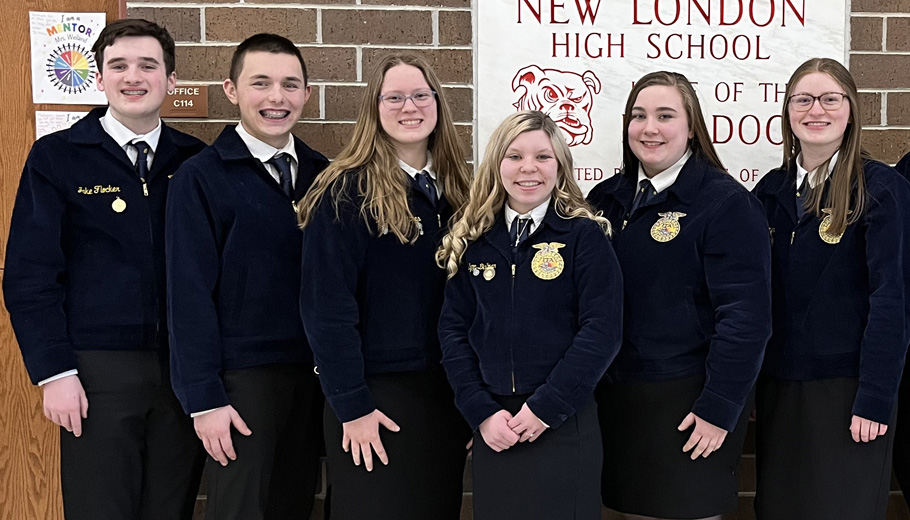
New London Economic Development Committee hears presentation
By Robert Cloud
Members of the New London FFA gave a presentation on immigration’s impact on dairy farming to the New London Economic Development Committee on May 30.
Five students portrayed various roles of the people affected by immigration and dairy farming.
Evan Retzlaff represented the interests of a large-scale dairy farmer, Hannah Gorman depicted a migrant farm worker from Mexico, Heidi Weyland was a student trying to balance the pros and cons of the issue, Carolyn Backes was an agriculture specialist with Homeland Security, and Jake Flocker characterized a small-scale farmer.
Weyland told committee members that dairy industry has been a key part of Wisconsin’s economy since the 19th century. The state now ranks No. 2 in the nation and produces more than 2.64 million pounds of milk monthly.
There are nearly 1.27 million dairy cows in Wisconsin with an average of 209 cows per farm.
Farmers milk cows two to three times a day, plus work in the fields and maintain their machinery.
“Who is helping the farmer?” Weyland asked. “Finding employees is challenging across the nation and in Wisconsin.”
Legislation
Backes explained some of the laws related to immigrant farm workers, beginning with H-2A that allows farmers to bring in temporary immigrant labor when they cannot find U.S. citizens to perform the work.
Small-scale and large-scale farmers criticized the law.
“It doesn’t help the dairy industry at all,” Retzlaff, on behalf of large farmers, said. “It only helps those who need seasonal help, which is not the dairy industry. We need workers year-round.”
“This is how I started my journey to becoming a U.S. citizen,” said Gorman, acting as a farm worker. “I worked here for short periods of time using this program before I was able to become a legal citizen.”
A farmer must apply with the federal government and be unable to fill the position to participate in the H-2A program,
Workers under the program must be provided with housing, transportation and a set pay rate.
It takes 75 days to acquire an H-2A permit, unless it’s an emergency, which makes it necessary to obtain the permit within 44 days.
“There’s no way I can afford to pay for the transportation and housing,” said Flocker on behalf of small farmers. “Workers are needed immediately, not in 75 days, especially if it’s an emergency.”
Backes noted that Congress is currently discussing the Farm Workforce Modernization Act, HR 1603, which would simplify the H-2A application process and reduce paperwork. She said HR 1603 would help dairy farmers because it opens the permits for nonseasonal, year-round farm workers.
”The only problem that comes from HR 1603 is it doesn’t give these immigrants full, legal, permanent status,” she said.
“Immigrant workers want to work full time, an eight-hour work day, 40 hours per week,” Retzlaff said. “This is great for me because I milk three times a day and can’t afford to rely on teenagers who have extracurricular activities at school and can only work certain days of the week.”
Retzlaff also noted that most local workers are not willing to work the third shift or work overtime.
He said immigrant farm workers are more willing to work overtime.
Backes pointed to the 3.4% unemployment rate in the United States.
“Americans want to work,” Backes said. “They just aren’t working in the dairy industry.”
Wages
Retzlaff said he cannot afford to pay the $25 per hour that the average American citizen earns.
“I can pay a noncitizen immigrant worker legally $17.34, which is a lot cheaper,” Retzlaff said.
Backes explained the “adverse effect wage rate,” a rule that sets a floor below which H-2A workers cannot be paid.
“I’m a citizen of the United States, so I am making $25 an hour,” Gorman said. “That is not the case for many immigrant workers in the dairy industry.”
Gorman said more than 80% of all immigrants working in the Wisconsin dairy industry are undocumented, “so this law does not help them.”
She said, “Undocumented immigrants are barely scraping by with wages that are not livable.”
“Immigrant workers hurt me and many other small farmers,” Flocker said, adding that small-scale farmers do not need as many employees as large farmers.
“I only milk twice a day versus three times a day that the large-scale farmers do,” Flocker said, describing life on his imaginary farm. “I milk in the early mornings with the help of my kids before they leave for school and then in the afternoons when they’re home from school.”
He argued that immigrant workers force small farmers to either expand or go out of business.
As a large-scale farmer, Retzlaff said he milks three times daily, at 3 a.m., 11 a.m. and 7 p.m.
“At each milking, I need one pusher and four milkers to get the entire herd milked in approximately seven hours in a double-20 parlor,” Retzlaff said. “At minimum, I need at least 10 full-time workers that work 65 to 70 hours a week just to milk the cows.”
Retzlaff said most U.S.-born citizens do not want to work that many hours.
Gorman also addressed the stereotypes that many Americans have about immigrants.
“We’re not all criminals or freeloaders,” he said. “We’re not here to take your jobs or your benefits. We’re here because we want a better life for ourselves and our families.”
